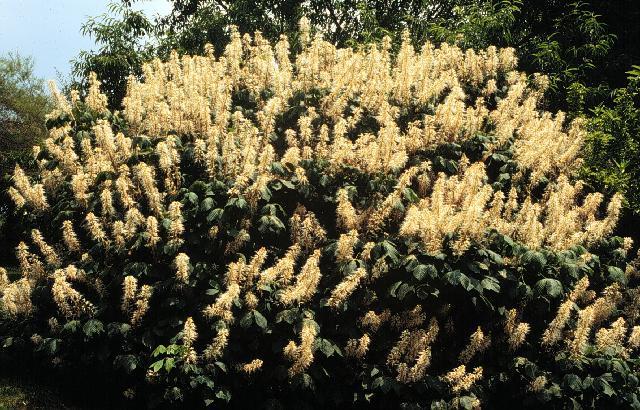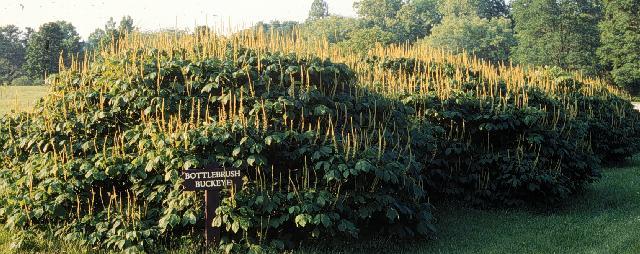2010 May Plants of the Month
Bob McNiel, Highland Moor Nursery, Frankfort, KY introduced two plants as LNA Plants of the month for May 2010; Aesculus parviflora and Hydrangea Oak Hill.
 Aesculus parviflora - Bottlebrush Buckeye is a favorite of most plants people. Bottlebrush buckeye was selected as one of the first year, 1999, Theodore Klein Plant Awardwinners. It is a beautiful plant that unlike many Aesculus maintains good foliage all season long. It is a slow growing multistemmed shrub, 8-10 feet high by 10-15 feet wide with beautiful flower spikes in June. It performs well in sun and shade. The fall color is an attractive mix of yellow and green (it was the cover photo for Mike Dirr's 1990, 4th edition of THE Manual of Woody Landscape Plants). One of the most famous stands of Bottlebrush Buckeye is the mass planting in full sun at Bernheim Arboretum (see below). Many plants are found growing in full sun including a nice planting at the Kentucky State Fairgrounds. Individual plants can be viewed at the UKREC planting
Aesculus parviflora - Bottlebrush Buckeye is a favorite of most plants people. Bottlebrush buckeye was selected as one of the first year, 1999, Theodore Klein Plant Awardwinners. It is a beautiful plant that unlike many Aesculus maintains good foliage all season long. It is a slow growing multistemmed shrub, 8-10 feet high by 10-15 feet wide with beautiful flower spikes in June. It performs well in sun and shade. The fall color is an attractive mix of yellow and green (it was the cover photo for Mike Dirr's 1990, 4th edition of THE Manual of Woody Landscape Plants). One of the most famous stands of Bottlebrush Buckeye is the mass planting in full sun at Bernheim Arboretum (see below). Many plants are found growing in full sun including a nice planting at the Kentucky State Fairgrounds. Individual plants can be viewed at the UKREC planting  and at the UK Arboretum. A very nice shade planting can be viewed at the Missouri Botanic Garden, St. Louis, MO. Bottlebrush buckeye is propagated by seed. The seed is collected just as the covering starts to crack (in west KY that is late September)and planted immediately. Cutting propagation from roots in the winter or softwood shoots has been successful.
and at the UK Arboretum. A very nice shade planting can be viewed at the Missouri Botanic Garden, St. Louis, MO. Bottlebrush buckeye is propagated by seed. The seed is collected just as the covering starts to crack (in west KY that is late September)and planted immediately. Cutting propagation from roots in the winter or softwood shoots has been successful.
Hydrangea macrophylla 'Oak Hill'
 Hydrangea macrophylla 'Oak Hill' is a "mop head" (syn Hortensia group) hydrangea. This means it will have, like others in the group, large, rounded heads of sterile flowers. It can flower more than once in a season (remontant) and will flower pink or blue depending on aluminum availability. Oak Hill blooms on new growth a very important factor for areas where winter cold may damage flower buds as is typical on Hydrangea macrophylla cultivars in Kentucky. This characteristic has made this a good choice for cut flowers. The bloom is predictable; occurring 100 days after early-June lateral bud break. While many put all remontant Hydrangea macrophyllas in a category as being very similar to the point of no real difference Dr. McNiel thinks this cultivar is superior.
Hydrangea macrophylla 'Oak Hill' is a "mop head" (syn Hortensia group) hydrangea. This means it will have, like others in the group, large, rounded heads of sterile flowers. It can flower more than once in a season (remontant) and will flower pink or blue depending on aluminum availability. Oak Hill blooms on new growth a very important factor for areas where winter cold may damage flower buds as is typical on Hydrangea macrophylla cultivars in Kentucky. This characteristic has made this a good choice for cut flowers. The bloom is predictable; occurring 100 days after early-June lateral bud break. While many put all remontant Hydrangea macrophyllas in a category as being very similar to the point of no real difference Dr. McNiel thinks this cultivar is superior.
